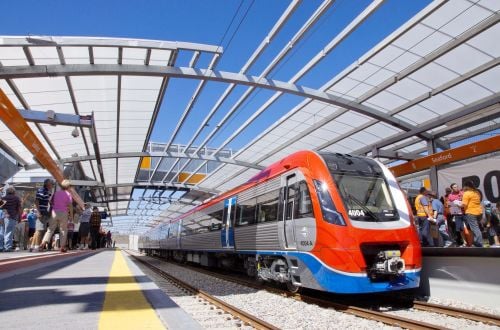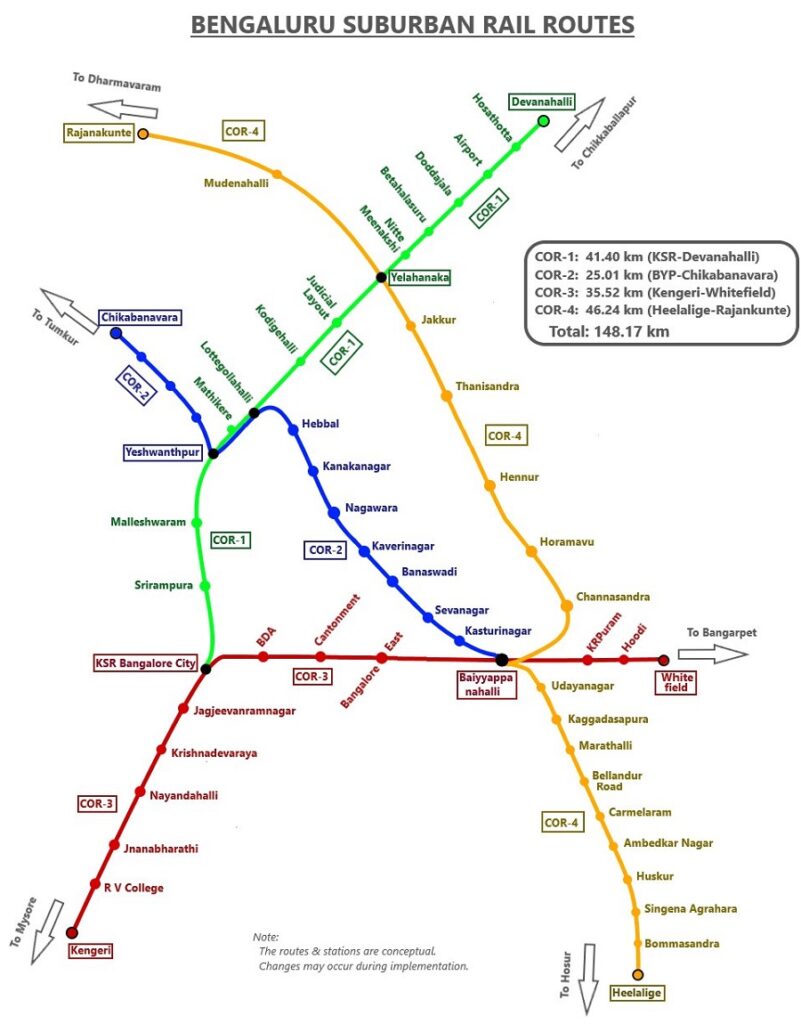The Bengaluru Suburban Rail Project (BSRP) is a transformative infrastructure initiative aimed at revolutionizing public transport in the bustling city of Bengaluru, India. This ambitious project, which has been in the planning stages since 1983, aims to provide a reliable and efficient commuter rail system that connects the city with its suburbs, significantly easing traffic congestion and enhancing the overall quality of life for residents.
Overview of the Bengaluru Suburban Rail Project
The BSRP is designed to cover a total length of 149.348 kilometers and will consist of four main corridors. The project aims to serve approximately 9.84 lakh passengers daily upon completion, providing an affordable and eco-friendly alternative to road transport.

source: railjournal
Key Details
- Total Length: 149.348 km
- Number of Stations: 64 planned stations
- Estimated Cost: ₹15,767 crore (approximately $2 billion)
- Completion Target: December 2026 for two corridors, with full completion expected by 2028
Corridor 1: Sampige Line
- Route: KSR Bengaluru – Yelahanka – Devanahalli
- Length: 41.478 km
- Type:
- Elevated: 19.22 km
- At-Grade: 22.278 km
- Depot: Akkupet Depot
- Number of Stations: 15 (8 elevated & 7 at-grade)
- Station Names:
| Station Name | Type |
|---|---|
| KSR Bengaluru City | Interchange |
| Srirampura | Future |
| Malleswaram | At-Grade |
| Yesvantpur | Interchange |
| Muthyal Nagar | At-Grade |
| Lottegollahalli | Interchange |
| Kodigehalli | At-Grade |
| Judicial Layout | At-Grade |
| Yelahanka | At-Grade |
| Nitte Meenakshi | At-Grade |
| Bettahalasoor | At-Grade |
| Doddajala | At-Grade |
| Airport Trumpet | At-Grade |
| Airport Terminal | At-Grade |
| Airport KIADB | At-Grade |
| Devanahalli | At-Grade |
Note: A suburban rail link is proposed to Bengaluru International Airport in this corridor.
Corridor 2: Mallige Line
- Route: Baiyyappanahalli Terminal – Chikkabanavara
- Length: 24.866 km
- Type:
- Elevated: 7.723 km
- At-Grade: 17.143 km
- Depot: Jalahalli Depot
- Number of Stations: 14 (6 elevated & 8 at-grade)
- Station Names:
| Station Name | Type |
|---|---|
| Chikka Banavara | At-Grade |
| Myadarahalli | At-Grade |
| Shettyhalli | At-Grade |
| Jalahalli (future) | Future |
| Yesvantpur (interchange) | Interchange |
| Lottegollahalli (interchange) | Interchange |
| Hebbal | At-Grade |
| Kanaka Nagar | At-Grade |
| Nagawara | At-Grade |
| Kaveri Nagar (future) | Future |
| Banaswadi | At-Grade |
| Seva Nagar | At-Grade |
| Kasturi Nagar | At-Grade |
| Baiyapanahalli (interchange) | Interchange |
Corridor 3: Parijaata Line
- Route: Kengeri – Whitefield
- Length: 35.52 km
- Type:
- Elevated: 10.40 km
- At-Grade: 25.12 km
- Number of Stations: 14 (4 elevated & 10 at-grade)
- Station Names:
| Station Name | Type |
|---|---|
| Kengeri | At-Grade |
| RV College (future) | Future |
| Jnanabharati | At-Grade |
| Nayandahalli | At-Grade |
| Krishnadevaraya | At-Grade |
| Jagjeevanram Nagar | At-Grade |
| KSR Bengaluru City (interchange) | Interchange |
| Kumara Park | At-Grade |
| Bengaluru Cantt | At-Grade |
| Bengaluru East | At-Grade |
| Baiyapannahalli | At-Grade |
| Krishnarajapura | At-Grade |
| Hoodi | At-Grade |
| Whitefield | At-Grade |
Corridor 4: Kanaka Line
- Route: Heelalige – Rajanukunte
- Length: 46.285 km
- Type:
- Elevated: 8.96 km
- At-Grade: 37.92 km
- Depot: Silkboard Depot
- Number of Stations: 19 (4 elevated & 15 at-grade)
- Station Names:
| Station Name | Type |
|---|---|
| Rajanukunte | At-Grade |
| Muddana Halli | At-Grade |
| Yelahanka | Interchange |
| Jakkur | At-Grade |
| Hegde Nagar | At-Grade |
| Thanisandra | At-Grade |
| Hennur | At-Grade |
| Horamavu | At-Grade |
| Channasandra | At-Grade |
| Benniganahalli | Interchange |
| Kagadaspura | At-Grade |
| Doddanekundi | At-Grade |
| Marathahalli | At-Grade |
| Belandur Road | At-Grade |
| Carmelaram | At-Grade |
| Ambedkar Nagar | At-Grade |
| Huskur | At-Grade |
| Singena Agrahara | Future |
| Bommasandra | Future |
Note: Five stations will serve as interchange stations across the corridors, enhancing connectivity and accessibility for commuters
Also read: Bengaluru Twin Tube Tunnels: Latest Insights, Cost & Major Corridors 2024
Bengaluru SubUrban rail project Route Map

source: themetrorailguy
Bengaluru SubUrban Rail Project Status:
Current Status of Corridors
1. Sampige Line
- Route: KSR Bengaluru – Yelahanka – Devanahalli
- Length: 41.478 km
- Status: A revised alignment plan has been submitted for approval. Tenders for the KSR Bengaluru City to Yelahanka section are expected to be opened on October 9, 2024. The line will include a direct link to Kempegowda International Airport.
2. Mallige Line
- Route: Baiyyappanahalli – Chikkabanavara
- Length: 24.866 km
- Status: The civil works contract was awarded to Larsen & Toubro in August 2022. The project has achieved 28% physical progress and is expected to complete the priority section from Chikkabanavara to Yeshwantpur by December 2025.
3. Parijaata Line
- Route: Kengeri – Whitefield
- Length: 35.52 km
- Status: The alignment plan is awaiting approval. Discussions are ongoing regarding shared tracks for part of the route.
4. Kanaka Line
- Route: Heelalige – Rajanukunte
- Length: 46.285 km
- Status: The civil works contract was awarded to L&T in 2023, with pre-construction activities currently underway.
Also read: Bengaluru Twin Tube Tunnels: Latest Insights, Cost & Major Corridors 2024
Bengaluru Suburban Rail Project Funded by:
The Bengaluru Suburban Rail Project (BSRP) is being funded through a combination of sources:
Government Funding
- The central government is providing 20% of the equity for the project.
- The state government of Karnataka is also contributing 20% of the equity.
External Loans
- The project is being funded by external assistance for up to 60% of the total cost.
- In December 2023, the German investment bank KfW signed an MoU for a €500 million (Rs 4,552 crore) loan for the project.
- In June 2024, the European Investment Bank (EIB) signed an MoU for a €300 million loan.
- Together, the €800 million (Rs 7,104 crore) loan from KfW and EIB covers 60% of the total project cost of Rs 15,767 crore.
Project Financing
- The remaining 40% of the project cost will be covered through a combination of state and central government equity.
Land Monetization
- Land monetization is also being explored as a source of funding for the project.
The funding mix of 20% equity each from the central and state governments, 60% external loans, and the remaining 20% through project financing and land monetization aims to make the BSRP financially viable and sustainable in the long run
Benefits of the Bengaluru Suburban Rail Project
The BSRP is expected to offer numerous benefits to commuters and the city as a whole:
1. Reduced Traffic Congestion
With the capacity to carry nearly 10 lakh passengers daily, the suburban rail system will significantly alleviate road traffic, particularly during peak hours.
2. Improved Connectivity
The project will connect various key residential and commercial areas across the city, making it easier for residents to access employment opportunities and amenities.
3. Environmental Impact
By promoting the use of public transport, the BSRP will contribute to reduced carbon emissions and lower air pollution levels in Bengaluru.
4. Economic Growth
The construction and operation of the suburban rail system are expected to create jobs and stimulate economic activity in the surrounding areas, contributing to the overall growth of the city.
5. Integrated Transport Solutions
The design includes provisions for seamless transfers between different modes of transport, enhancing the overall commuting experience for users
Unique Facilities of the Bengaluru Suburban Rail Project
1. Integrated Commercial Hubs
Many stations within the BSRP will be designed as integrated commercial hubs. These hubs will not only serve as transit points but will also house shopping, dining, and recreational facilities, allowing commuters to engage in various activities before or after their journeys. This design aims to create a vibrant atmosphere around the stations, contributing to the local economy.
2. Intermodal Integration
The BSRP will feature intermodal integration hubs at various stations, facilitating seamless transitions between different modes of transport. Commuters will be able to switch easily between the suburban rail, metro trains, public buses, and other transport services, mirroring the efficient systems found in European cities. This integration will enhance the overall commuting experience and reduce travel time.
3. Automated Fare Collection
To streamline the travel process, the project will implement an automated fare collection system. This technology will allow for quick and efficient ticketing, minimizing queues and wait times at stations. Additionally, platform screen doors will be installed to enhance safety and improve passenger flow.
4. Modern Rolling Stock
The BSRP plans to utilize modern Metro Train sets (EMU), specifically the RS 13 series used in the Delhi Metro, which are manufactured locally by BEML in Bangalore. These trains will provide a comfortable and efficient travel experience, equipped with features that cater to the needs of daily commuters.
5. Last-Mile Connectivity Solutions
To ensure that commuters can reach their final destinations easily, the BSRP will incorporate last-mile connectivity solutions. This includes Public Bicycle Sharing (PBS) and Shared Micro-Mobility Systems, which will provide options for commuters to travel short distances after disembarking from the train.
6. Smart Station Hubs
All 57 stations in the project will be transformed into Smart Station Hubs. These hubs will be multi-storey facilities that support various businesses, including retail, hospitality, and co-working spaces. They will be designed to optimize the use of air space for commercial activities while ensuring easy access to different transport modes.
Also read: Bengaluru Twin Tube Tunnels: Latest Insights, Cost & Major Corridors 2024
Bengaluru SubUrban Rail Automated Fare Collection System(AFC):
Overview of the Automated Fare Collection System
The AFC system is a modern solution that automates the ticketing process for public transportation, making it more efficient and user-friendly. It comprises several key components that work together to facilitate seamless fare collection.
Key Components of the AFC System
- Automatic Gate Machines (AGM): These gates will allow passengers to enter and exit the station by validating their tickets or smart cards. The gates will open automatically for valid entries, ensuring smooth passenger flow, especially during peak hours.
- Ticket Vending Machines (TVM): These self-service machines will enable passengers to purchase tickets or top-up their smart cards. They will accept various payment methods, including cash, cards, and mobile payments, making the ticket purchasing process convenient.
- Ticket Checking Machines (TCM): Positioned at entry and exit points, these machines will validate the tickets or smart cards. They will ensure that passengers have paid the correct fare before allowing access to the platform.
- Mobile Ticketing: The AFC system will support mobile ticketing options, allowing passengers to purchase and store tickets on their smartphones. This feature will promote contactless travel and reduce the need for physical tickets.
How the AFC System Works
- Purchase of Tickets: Passengers can buy tickets through TVMs or mobile applications. The system will support various payment methods, including contactless options like Near Field Communication (NFC) and EMV (Europay, MasterCard, and Visa) cards.
- Entry to the Station: Upon arriving at the station, passengers will approach the automatic gates. They will tap their smart cards or scan QR codes at the gate. The AFC system will validate the ticket against the centralized database, checking for sufficient balance or validity.
- Exit from the Station: After completing their journey, passengers will again use the automatic gates to exit. The system will calculate the fare based on the entry and exit points, deducting the appropriate amount from the passenger’s balance.
- Real-Time Data Collection: The AFC system will continuously collect and transmit data regarding passenger flow and fare collection to a central system. This data will be used for analytics, helping transport authorities optimize operations and improve service delivery.
Benefits of the AFC System
- Reduced Queues: The automated nature of the fare collection process will minimize wait times at stations, especially during peak hours, allowing for a smoother commuter experience.
- Enhanced Security: The AFC system will incorporate security features such as encryption for payment transactions, ensuring safe and secure fare collection.
- Integration with Other Transport Modes: The AFC system is designed to integrate with other public transport systems, enabling a unified ticketing experience across different modes of transport, such as buses and metro services.
- User-Friendly Experience: With options for mobile ticketing and self-service machines, the AFC system aims to provide a more convenient and accessible fare collection method for all passengers.
Frequently Asked Questions:
The Bengaluru Suburban Rail Project (BSRP) is an infrastructure initiative aimed at developing a commuter rail network in the Bangalore Metropolitan Region to alleviate traffic congestion and improve public transportation efficiency.
The BSRP will span approximately 149.348 km and will feature a total of 64 stations across four main corridors.
The four corridors are:Sampige Line: KSR Bengaluru – Yelahanka – Devanahalli
Mallige Line: Baiyyappanahalli Terminal – Chikkabanavara
Parijaata Line: Kengeri – Whitefield
Kanaka Line: Heelalige – Rajanukunte
The automated fare collection system will include ticket vending machines, automatic gate machines, and mobile ticketing options to streamline the ticketing process, reduce queues, and enhance the overall commuter experience.
The entire project is targeted for completion by December 2027, with the first two corridors expected to be operational by December 2026.
Suggested Articles:
Bengaluru Twin Tube Tunnels: Latest Insights, Cost & Major Corridors 2024
17 Elevated Corridor Bangalore : A Comprehensive Guide to the projec
Bengaluru Double Decker Flyover: Stations, Route and Latest news







































